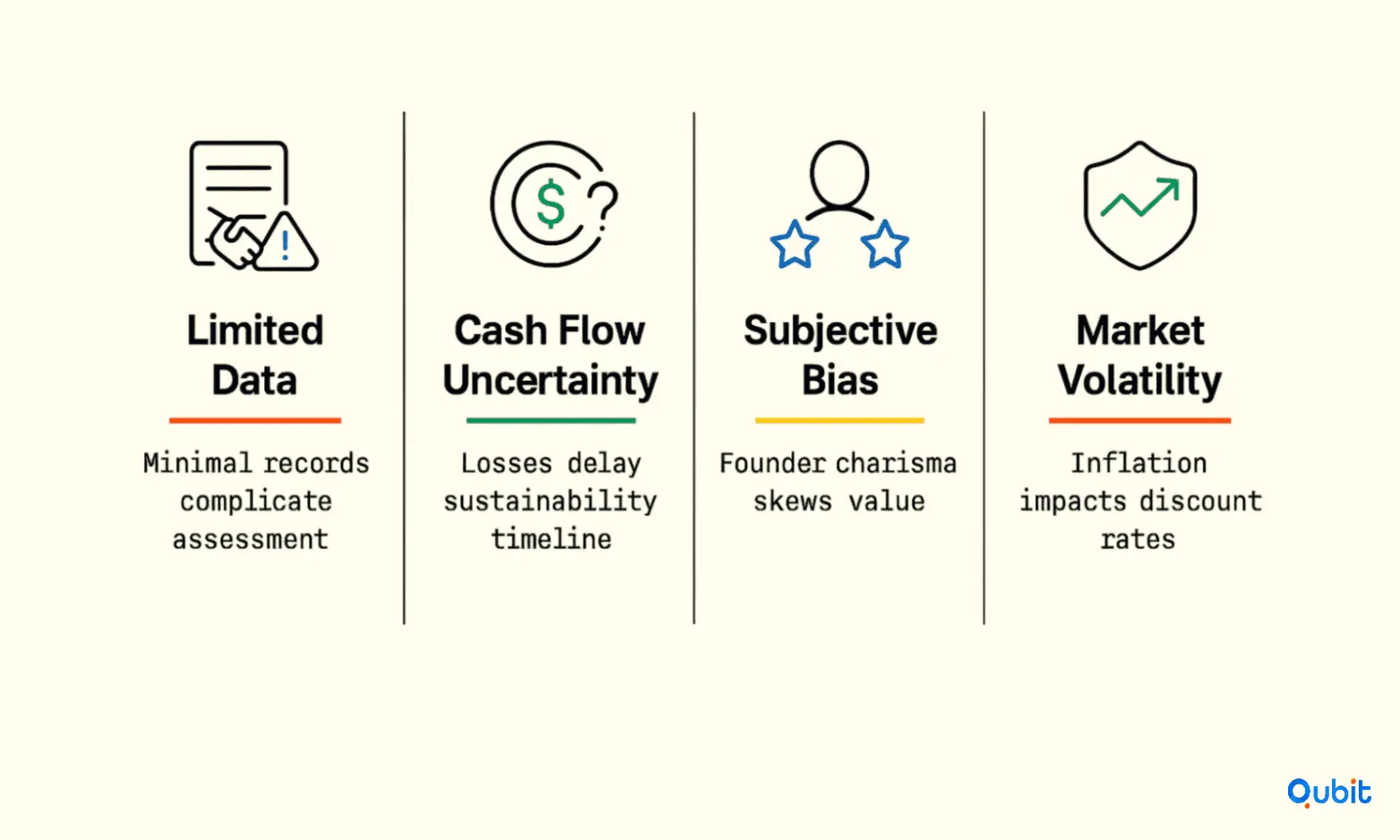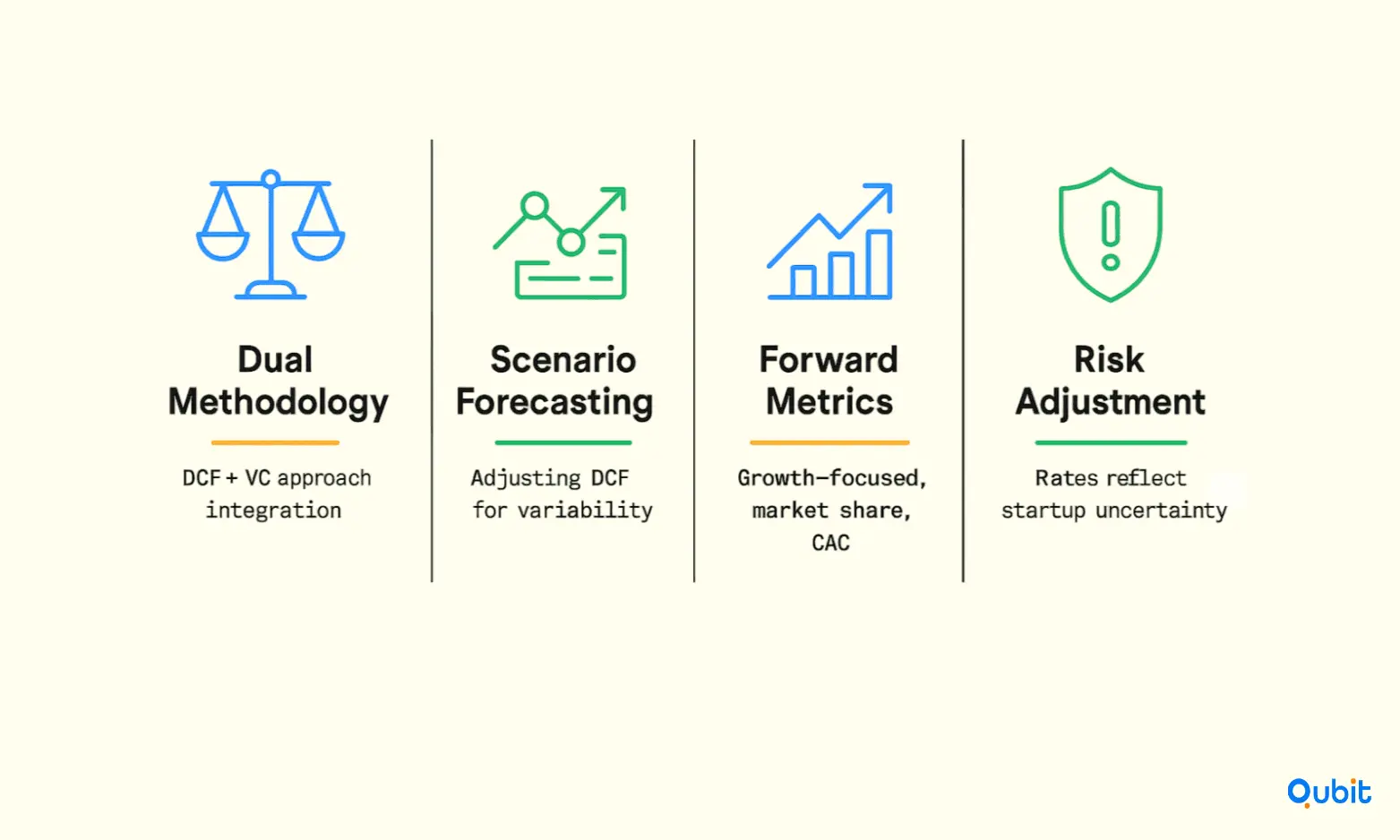Investing in startups is part numbers and part judgment. You need hard analysis to avoid overpaying, and clear qualitative reads to back teams that can execute when reality changes. With a $16 million median seed valuation, the market is competitive and mistakes get expensive fast.
Funding conditions also shift quickly, which changes what gets backed. In Q2 2025, global startup funding reached $91 billion, an 11% year over year increase. That uptick signals more competition for high quality deals and higher selectivity across the rest.
In this guide, you will learn how to evaluate and select startup investment deals using a structured approach. You will see what to prioritize, how to compare opportunities, and how to make decisions that match your fund strategy and risk profile.
Startup Valuation Methods and Strategies
This section explains how investors value startups when financial history is limited. You will see which methods fit each stage, plus the inputs you need to run them.
Valuation usually blends multiple approaches. Investors use the Berkus, Scorecard, Market Multiples, and DCF approaches to compare, benchmark, and adjust expectations for risk. Early-stage startups need specialized frameworks, because traditional methods break when data is thin.
Defining Key Valuation Inputs
Each method needs a different input set. Collect financial figures where available, plus comparable metrics and qualitative factors like team expertise and market position. The cleaner your inputs, the fewer valuation arguments you will fight later.
Sector Adjustments For Market Multiples
Multiples vary by category, so benchmarks must be sector-aware. In 2025, AI companies averaged 23.4x revenue multiples, with leading private startups reaching 37.5x. These levels sit far above traditional SaaS ranges, so your comps must match your sector and growth profile.
Comparing Valuation Results
Different methods can produce very different answers. That variance comes from the assumptions you choose, like revenue multiple ranges versus discounted cash flow scenarios. The goal is not one perfect number. The goal is a defendable range tied to evidence.
Aligning Valuation Narratives with Realistic Milestones
Building on stage-based benchmarks, founders should align their valuation narratives with realistic milestones and relevant market comparables. This approach grounds discussions in credible achievements rather than aspirational projections alone. By referencing concrete progress and industry standards, founders reduce the risk of overvaluation and increase investor confidence. Transparent communication about milestones also strengthens long-term relationships with stakeholders.
Your early strategy may benefit from the insights highlighted in startup outreach for investors, which contextualizes initial investor engagement within the broader investment process.
Avoid Pitfalls: Challenges in Startup Valuation
Startup valuation is no straightforward task. Unlike established companies, startups often lack the financial history and predictable cash flows that make traditional valuation methods reliable.

- Limited Financial History And Data Gaps
Startups often have thin reporting and short track records, so projections carry more guesswork. A key failure mode is overvaluing the story while underchecking demand. Research shows 34% of startups fail due to poor product market fit, so pressure test traction signals before you price upside. - Uncertainty In Cash Flows
Most early stage startups burn cash by design. That makes DCF style logic fragile, because small assumption changes swing outcomes hard. Treat forecasts as scenarios, not promises, and link them to measurable milestones. - The Role Of Subjective Bias
Charisma, hype cycles, and fear of missing out can inflate valuation. Separate founder storytelling from proof, and compare against clear comps and stage benchmarks. If the deal only works under perfect assumptions, it is not priced right. - Inflation And Market Volatility
Macro shifts change what a startup is worth today. Inflation pushes discount rates up, which lowers the present value of future cash flows. Bake that into risk discussions, especially when negotiating high multiples in uncertain markets.
Your review of investment opportunities gains clarity as startup due diligence steps detail a sequential process that outlines each phase of risk and viability analysis. However, even with thorough due diligence, the absence of concrete data can leave room for significant uncertainty.
Assessing Startup Growth Potential
Understanding a startup’s growth potential requires a multi-dimensional approach that evaluates key factors influencing its trajectory. From market trends to scalability, competitive advantages, and execution capabilities, each element plays a pivotal role in shaping future projections.
1. Analyzing Market Trends
Market trends often serve as a compass for predicting growth opportunities. Startups operating in sectors with increasing valuation milestones, such as those tied to product development, revenue generation, or team expansion, are likely to attract greater investor confidence. Discussing how meeting different milestones, product, revenue, team growth, impacts the perceived potential highlights the importance of aligning with evolving industry benchmarks.
Additionally, your market analysis is enhanced by the perspective offered in how to assess product-market fit, which examines the balance between customer demand and competitive dynamics. This resource provides valuable insights into identifying market demand while addressing competitive pressures, ensuring startups can position themselves effectively for sustained growth.
2. Evaluating Scalability
Scalability is a cornerstone of startup success. A scalable business model ensures that growth can be achieved without proportionally increasing costs. Startups with adaptable processes, efficient operations, and the ability to expand into new markets or demographics demonstrate higher growth potential.
3. Competitive Advantages
A startup’s ability to differentiate itself from competitors often determines its long-term viability. Unique value propositions, proprietary technology, or exclusive partnerships can create barriers to entry for competitors, solidifying the startup's position in the market.
4. Execution Capabilities
Even the most promising ideas can falter without strong execution. Assessing the leadership team's expertise, operational efficiency, and ability to adapt to challenges is crucial. Execution capabilities often act as the bridge between potential and realized growth.
By combining these dimensions, market trends, scalability, competitive advantages, and execution capabilities—investors and founders can make informed decisions about a startup’s growth trajectory.
Intellectual Property And Valuation: How To Maximize IP Value
Intellectual property can lift a startup’s valuation, especially in tech-led markets. IP strengthens positioning and creates barriers to entry, which makes the intellectual property valuation significance hard to ignore when investors compare similar companies.
Strong IP portfolios signal defensibility. Patents, trademarks, copyrights, and trade secrets act as proof of innovation and ownership. A patent can protect differentiation in a crowded market, while trademarks strengthen brand recall and trust over time.
IP only matters if it is managed well. Weak protection creates real risk, like infringement claims, lost exclusivity, or unclear ownership. Secure protections early where it makes sense, and run periodic IP audits so coverage stays aligned with the product roadmap.
IP can also become a revenue lever. Licensing deals, partnerships, and other monetization paths can turn IP into cash flow, not only a moat. This is especially relevant in biotech, software, and energy, where innovation is the core asset.
To maximize value, treat IP like a strategy, not paperwork. Build it deliberately, protect it cleanly, and use it to support differentiation, pricing power, and partnership leverage.
Major corporations also treat IP expansion as strategic. In 2024, Microsoft invested $1.7 billion in cloud and AI technology in Indonesia. This underscores how strategic IP expansion drives valuation and market positioning.
How Management Teams Shape Startup Valuation
A startup’s management team often drives the valuation more than the product, especially early on. Investors assess founder team influence on valuation by looking at whether the team can execute, adapt, and scale without breaking the business.
Background matters because it signals speed and judgment. Investors look for domain expertise, execution history, and evidence the team can handle setbacks. Founders with prior exits or leadership roles can reduce perceived risk, which can support higher valuations.
Team dynamics matter just as much. A strong team has clear roles, shared decision making, and the ability to resolve conflict under pressure. If collaboration is weak, valuation confidence drops because execution becomes unpredictable.
Networks also shape valuation. A well connected team can unlock customers, hires, partnerships, and follow on capital faster. That access improves the probability of hitting milestones, which investors often price into the deal.
In the end, investors are not only valuing the market and the product. They are valuing the people who will navigate the hard parts and create the outcome.
Your assessment of human factors is enriched when how to evaluate a startup team provides a detailed look at the traits and dynamics that underpin a startup’s potential.
Integrating Insights: Bringing It All Together
A strong startup valuation framework is not only math. It is the combination of quantitative inputs and qualitative judgment, applied consistently.
The Value Of Regularly Updating Startup Valuations
Valuations should not be treated as a one time output. Update them when milestones change or market conditions shift, so decisions stay grounded in current reality. This reduces outdated assumptions, improves negotiation quality, and keeps expectations aligned for both investors and founders.
Use Multiple Methods, Not One Number
Combine valuation methods to balance what the market is paying with what the business can realistically deliver. For example, a SaaS startup might use the Scorecard method for market benchmarks, then sanity check with a light DCF using conservative assumptions. Adjust the range based on execution strength and risk factors.
Keep The Output Practical
A good framework produces a defendable range, not a perfect answer. It also prevents one metric from dominating the decision, which leads to more consistent outcomes across deals.
Case Study Spotlight: PwC's Startup Valuation
When PwC undertook the valuation of a Lithuanian transport startup, their approach combined precision with adaptability. This case study highlights how PwC utilized a tailored Discounted Cash Flow (DCF) model alongside the Venture Capital (VC) method to address the unique challenges of valuing a high-growth startup. By focusing on forward-looking metrics and risk-adjusted projections, PwC demonstrated the importance of customizing valuation techniques to align with the dynamic nature of startups.

A Dual-Methodology Approach
PwC’s strategy began with the DCF model, which is often favored for its ability to project future cash flows and discount them to present value. However, for startups, where cash flows are often uncertain, PwC adjusted the model to incorporate scenario-based forecasting. This allowed them to account for the variability in revenue streams and operational costs.
Simultaneously, the VC method was employed to complement the DCF analysis. This method, widely used in startup valuations, focuses on the expected return on investment for venture capitalists. By integrating these two approaches, PwC ensured that the valuation captured both the intrinsic value of the startup and the market-driven expectations of potential investors.
Global interest in startup valuation strategies is evident at premier events. The VivaTech event saw over 3,200 investors, with unmatched decision-maker engagement in Europe. This depth of participation highlights how tailored frameworks capture attention and resources.
Focus on Forward-Looking Metrics
One of the standout aspects of this valuation was PwC’s emphasis on forward-looking metrics. Traditional valuation methods often rely heavily on historical financial data, which can be sparse or irrelevant for startups. Instead, PwC prioritized metrics such as projected market share, customer acquisition rates, and scalability potential. This shift in focus provided a more accurate representation of the startup’s growth trajectory.
Addressing Startup-Specific Risks
Startups face unique risks, from market volatility to operational uncertainties. PwC accounted for these by applying risk-adjusted discount rates in their DCF model. This adjustment ensured that the valuation reflected the higher level of uncertainty associated with early-stage businesses. As an innovative transport system developer, the Lithuanian startup presented specific challenges, such as regulatory hurdles and technological adoption rates, which were carefully factored into the analysis.
This real-world example underscores how corporate valuation giants like PwC tailor their approach to startup-specific risks, ensuring that the valuation is both realistic and actionable.
Implementing the VC Method for Startup Valuation
The VC method helps you value a startup by working backward from a future exit. It is especially useful when a company has limited financial history or inconsistent revenue.
- Use It As A Framework, Not A Single Answer
The VC method balances upside with risk in a structured way. It helps you anchor valuation discussions around exit potential, required returns, and realistic ownership expectations. - Estimate The Exit Value
Start by projecting what the company could sell for or IPO at in the future. Base this on comparable outcomes, market trends, and category benchmarks. - Discount The Exit To Present Value
Convert the future exit into today’s value using a risk adjusted discount rate. Early stage deals carry high uncertainty, so discount rates are often in the 30% to 70% range. Higher risk means a higher discount. - Calculate The Ownership You Need
Determine the stake required to hit your return target. Divide your investment amount by the present value of the projected exit. Example: if you invest $1 million and the discounted exit value is $10 million, you would need 10% ownership.
Applying the Practical Scorecard Valuation Method
Quantifying a startup’s value can feel like a daunting task, but the practical scorecard valuation method simplifies this process through a structured approach. This method adjusts a startup’s valuation by comparing it to industry benchmarks and applying weighted qualitative criteria.
Step 1: Establish a Baseline Valuation
The process begins with identifying a baseline valuation for startups in the same industry and region. This benchmark serves as the foundation for adjustments based on the startup’s unique attributes.
Step 2: Define Key Evaluation Criteria
Next, the scorecard method evaluates qualitative factors that influence a startup’s potential. These typically include:
- Management Team: Assessing the experience, expertise, and track record of the leadership team.
- Market Opportunity: Evaluating the size and growth potential of the target market.
- Competitive Positioning: Analyzing how the startup differentiates itself from competitors.
- Product/Technology: Reviewing the innovation, scalability, and defensibility of the product or service.
- Business Stage: Considering the startup’s current development phase and traction.
Step 3: Assign Weights and Scores
Each criterion is assigned a weight based on its importance to the startup’s success. For example, a strong management team might carry more weight than other factors. Scores are then assigned to each criterion based on how well the startup performs in that area.
Step 4: Calculate the Adjusted Valuation
The final step involves multiplying the baseline valuation by the weighted scores. This adjustment reflects the startup’s strengths and weaknesses relative to the benchmark.
By quantifying qualitative factors, the practical scorecard valuation method offers a balanced and transparent approach to startup valuation.
Conclusion
Startup investing is a blend of analysis and judgment, and valuation is where mistakes get expensive fast. You need a structured way to price risk, avoid hype, and stay consistent across deals. Use multiple valuation methods to triangulate a defendable range, not a single perfect number. Start with clean inputs, relevant comparables, and assumptions tied to real milestones.
Pressure-test scenarios so the deal still works when growth slows or costs rise. Factor in qualitative signals too, like team strength, market timing, defensibility, and execution ability. Revisit valuation as new evidence shows up, so pricing stays grounded in reality.
If you're ready to pinpoint the next high-potential startup deals, we at Qubit Capital can help with our Startup Matchmaking service. Let’s get started.
Key Takeaways
- Use both numbers and judgment, because pricing errors get expensive at a $16 million median seed valuation.
- Global funding hit $91 billion in Q2 2025, up 11% year over year, raising competition for top deals.
- Blend methods, including Berkus, Scorecard, market multiples, DCF, and VC method, to land a defendable valuation range.
- Make comps sector-aware, since AI averaged 23.4x revenue multiples in 2025, with leaders reaching 37.5x.
- Expect variance across methods, because assumptions drive outcomes more than spreadsheets do, especially with thin data.
- Guard against overvaluing the story, since 34% of startups fail from poor product-market fit.
- Use the VC method as a framework, with risk-adjusted discount rates often between 30% and 70%.
- Treat valuation as a living output, updating it when milestones or market conditions shift to avoid stale negotiations.
Frequently asked Questions
What are the most popular startup valuation methods used by investors?
Common startup valuation methods include the Berkus Method, Scorecard Valuation, DCF, and Venture Capital Method. Each approach helps investors assess a startup’s value.






